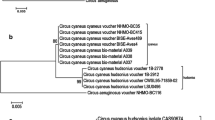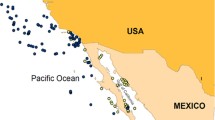Abstract
The evolutionary history of three out of four birds traditionally classified into the genus Rhodopechys birds has been studied by comparing their mitochondrial cytochrome b DNA sequence with that of greenfinches and other genus Carduelis finches. The desert finch (Rhodopechys obsoleta) or a sister extinct species seems to have existed about 6 million years ago in Asian and perhaps African desert-like areas. This bird has no molecular relationship with other Rhodopechys birds and seems to have given rise to the greenfinches radiation, probably by allopatry of marginal or isolated groups; the latter would have evolved to green plumage colours and more simple song modulations (i.e., greenfinches). The possible role of assortative mating and the newly postulated acquired phenotypic characters in greenfinches speciation are discussed.


Similar content being viewed by others
References
Allende LM, Rubio I, Ruiz-del-Valle V, Guillen J, Martinez-Laso J, Lowy E, Varela P, Zamora J, Arnaiz-Villena A (2001) The Old World sparrows (genus Passer) phylogeography and their relative abundance of nuclear mtDNA pseudogenes. J Mol Evol 53:144–154
Arnaiz-Villena A, Alvarez-Tejado M, Ruiz-del-Valle V, Garcia-de-la-Torre C, Varela P, Recio MJ, Ferre S, Martinez-Laso J (1998) Phylogeny and rapid northern and southern hemisphere speciation of goldfinches during the Miocene and Pliocene epochs. Cell Mol Life Sci 54:1031–1041
Arnaiz-Villena A, Alvarez-Tejado M, Ruiz-del-Valle V, Garcia-de-la-Torre C, Varela P, Recio MJ, Ferre S, Martinez-Laso J (1999) Rapid radiation of canaries (Genus Serinus). Mol Biol Evol 16:2–11
Arnaiz-Villena A, Guillen J, Ruiz-del-Valle V, Lowy E, Zamora J, Varela P, Stefani D, Allende LM (2001) Phylogeography of crossbills, bullfinches, grosbeaks, and rosefinches. Cell Mol Life Sci 58:1159–1166
Arnaiz-Villena A, Timon M, Corell A, Perez-Aciego P, Martin-Villa JM, Regueiro JR (1992) Primary immunodeficiency caused by mutations in the gene encoding the CD3-gamma subunit of the T-lymphocyte receptor. N Engl J Med 327:529–533
Blake N (2001) Trumpeter finch. http://www.nigelblake.co.uk
Burns KJ (1997) Molecular systematics of tanagers (Thraupinae): evolution and biogeography of a diverse radiation of neotropical birds. Mol Phylogenet Evol 8:334–348
Burtt EHJ, Ichida JM (2004) Gloger’s rule, feather-degrading bacteria, and color variation among Song Sparrows. Condor 106:681–686
Cibois A, Pasquet E, Schulenberg TS (1999) Molecular systematics of the malagasy babblers (Passeriformes: Sylviidae), Based on cytochrome b and 16S rRNA sequences. Mol Phylogenet Evol 13:581–595
Cicero C, Johnson NK (1998) Molecular phylogeny and ecological diversification in a clade of New World songbirds (genus Vireo). Mol Ecol 7:1359–1370
Clement P, Harris P, Davies J (1993) Finches and Sparrows. Christopher Helm, London
Desjardins P, Morais R (1990) Sequence and gene organization of the chicken mitochondrial genome. A novel gene order in higher vertebrates. J Mol Biol 212:599–634
Edwards SV, Arctander P, Wilson AC (1991) Mitochondrial resolution of a deep branch in the genealogical tree for perching birds. Proc R Soc Lond B 243:99–107
Erard C, Etchécopar RD (1970) Contribution à l’étude des oiseaux d’Iran (Résultats de la mission Etchecopar 1967). du Muséum, Paris
Ericson PGP, Christidis L, Irestedt M, Norman JA (2002) Systematic affinities of the lyrebirds (Passeriformes: Menura), with a novel classification of the major groups of passerine birds. Mol Phylogenet Evol 25:53–62
Felsenstein J (1981) Evolutionary trees from DNA sequences: a maximum likelihood approach. J Mol Evol 17:368–376
Felsenstein J (1985) Confidence limits of phylogenies: an approach using the bootstrap. Evolution 39:783–795
Fitch WM (1971) Toward defining the course of evolution, minimum change from a specific tree topology. Syst Zool 20:406–415
Fleischer RC, McIntosh C, Tarr CL (1998) Evolution on a volcanic conveyor belt: using phylogeographic reconstructions and K-Ar-based ages of the Hawaiian Islands to estimate molecular evolutionary rates. Mol Ecol 7:533–545
Friesen VL, Montevecchi WA, Baker AJ, Barrets RT, Davidson WS (1996) Population differentiation and evolution in the common guillemot Uuria aalge. Mol Ecol 5:793–805
Gill FB (1999) Ornithology. Freeman, New York
Grant PR, Grant BR (1997) Genetics and the origin of bird species. Proc Natl Acad Sci USA 94:7768–7775
Groth JG (1998) Molecular phylogenetics of finches and sparrows: consequences of character state removal in cytochrome b sequences. Mol Phylogenet Evol 10:377–390
Haavie J, Borge T, Bures S, Garamszegi LZ, Lampe HM, Moreno J, Qvarnström A, Török J, Sætre GP (2004) Flycatcher song in allopatry and sympatry—convergence, divergence and reinforcement. J Evol Biol 17:227–237
Hackett SJ (1996) Molecular phylogenetics and biogeography of tanagers in the genus Ramphocelus (Aves). Mol Phylogenet Evol 5:368–382
Hasegawa M, Kishino H, Yano T (1985) Dating of the human-ape splitting by a molecular clock of mitochondrial DNA. J Mol Evol 22:160–174
Hasegawa M, Thorne JL, Kishino H (2003) Time scale of eutherian evolution estimated without assuming a constant rate of molecular evolution. Genes Genet Syst 78:267–283
Helbig AJ, Seibold I (1999) Molecular phylogeny of Paleartic-African Acrocephalus and Hippolais warblers (Aves: Sylviidae). Mol Phylogenet Evol 11:246–260
Hillis DM, Huelsenbeck JP, Cunningham CW (1994) Application and accuracy of molecular phylogenies. Science 264:671–677
Irwin DM, Kocher TD, Wilson AC (1991) Evolution of the cytochrome b gene of mammals. J Mol Evol 32:128–144
Jukes TH, Cantor CR (1969) Evolution of protein molecules. Academic Press, New York
Kishino H, Hasegawa M (1989) Evaluation of the maximum likelihood estimate of the evolutionary tree topologies from DNA sequence data, and the branching order in hominoidea. J Mol Evol 29:170–179
Klicka J, Zink RM, Winkler K (2003) Longspurs and snow buntings: phylogeny and biogeography of a high-latitude clade (Calcarius). Mol Phylogenet Evol 26:165–175
Kocher TD, Thomas WK, Meyer A, Edwards SV, Paabo S, Villablanca FX, Wilson AC (1989) Dynamics of mitochondrial DNA evolution in animals: amplification and sequencing with conserved primers. Proc Natl Acad Sci USA 86:6196–6200
Kornegay JR, Kocher TD, Williams LA, Wilson AC (1993) Pathways of lysozyme evolution inferred from the sequences of cytochrome b in birds. J Mol Evol 37:367–379
Krajewski C, King DG (1996) Molecular divergence and phylogeny: rates and patterns of cytochrome b evolution in cranes. Mol Biol Evol 13:21–30
Kriukov AP, Suzuki H (2000) Phylogeographic carrion, hooded and jungle crows (Aves, Corvidae) from data on partial sequencing of the mitochondrial DNA cytochrome B gene. Genetika 36:1111–1118
Kumar S, Tamura K, Ingrid B, Nei M (2001) MEGA2: Molecular evolutionary genetics analysis software, Version 2.0. Arizona State University, Tempe
Li W, Wu C, Luo C (1985) A new method for estimating synonymous and non-synonymous rates of nucleotide substitution considering the relative likelihood of nucleotide and codon changes. Mol Biol Evol 2:150–174
Lockhart PJ, Steel MA, Hendy MD, Penny D (1994) Recovering evolutionary trees under a more realistic model of sequence evolution. Mol Biol Evol 11:605–612
Lougheed SC, Freeland JR, Handford P, Boag PT (2000) A molecular phylogeny of Warbling-Finches (Poospiza): paraphyly in a neotropical emberizid genus. Mol Phylogenet Evol 17:367–378
McNaught MK, Owens IPF (2002) Interspecific variation in plumage colour among birds: species recognition or light environment? J Evol Biol 15:505–514
Nei M (1987) Molecular evolutionary genetics. Columbia University Press, New York
Nei M, Gojobori T (1986) Simple methods for estimating the numbers of synonymous and non-synonymous nucleotide substitutions. Mol Biol Evol 3:418–426
Norman JA, Christidis L, Joseph L, Slikas B, Alpers D (2002) Unravelling a biogeographical knot: origin of the “leapfrog” distribution pattern of Australo-Papuan sooty owls (Strigiformes) and logrunners (Passeriformes). Proc R Soc Lond B 269:2127–2133
Omland KE, Tarr CL, Boarma WI, Marzluff JM, Fleischer RC (2000) Cryptic genetic variation and paraphyly in ravens. Proc R Soc Lond B 22:2475–2482
Packert M, Martens J, Kosuch J, Nazarenko AA, Veith M (2003) Phylogenetic signal in the song of crests and kinglets (Aves: Regulus). Evolution Int J Org Evolution 57:616–629
Pamilo P, Bianchi N (1993) Evolution of the Zfx and Zfy, genes: rates and interdependence between the genes. Mol Biol Evol 10:271–281
Pasquet E, Cibois A, Baillon F, Erard C (2002) What are African monarchs (Aves, Passeriformes)? A phylogenetic analysis of mitochondrial genes. C R Biol 325:107–118
Prager EM, Wilson AC (1988) Ancient origin of lactalbumin from lysozyme: analysis of DNA and amino acid sequences. J Mol Evol 27:326–335
Questiau S, Eybert MC, Gaginskaya AR, Gielly L, Taberlet P (1998) Recent divergence between two morphologically differentiated subspecies of bluethroat (Aves: Muscicapidae: Luscinia svecica) inferred from mitochondrial DNA sequence variation. Mol Ecol 7:239–245
Saitou N, Nei M (1987) The neighbor-joining method: a new method for reconstructing phylogenetic trees. Mol Biol Evol 4:406–425
Salzburger W, Martens J, Nazarenko AA, Sun YH, Dallinger R, Sturmbauer C (2002a) Phylogeography of the Eurasian Willow Tit (Parus montanus) based on DNA sequences of the mitochondrial cytochrome b gene. Mol Phylogenet Evol 24:26–34
Salzburger W, Martens J, Sturmbauer C (2002b) Paraphyly of the Blue Tit (Parus caeruleus) suggested from cytochrome b sequences. Mol Phylogenet Evol 24:19–25
Sato A, O’hUigin C, Figueroa F, Grant PR, Grant BR, Tichy H, Klein J (1999) Phylogeny of Darwin’s finches as revealed by mtDNA sequences. Proc Natl Acad Sci USA 96:5101–5106
Sato A, Tichy H, O’hUigin C, Grant PR, Grant BR, Klein J (2001) On the origin of Darwin’s finches. Mol Biol Evol 18:299–311
Sibley C, Ahlquist J (1990) Phylogeny and classification of birds: a study in molecular evolution. Yale University Press, New Haven
Swofford DL (2002) PAUP*. Phylogenetic analysis using parsimony (* and other methods) Version 4. Sinauer, Sunderland, Mass.
Templeton A (1983) Phylogenetic inference from restriction endonuclease cleavage site maps with particular reference to the evolution of humans and the apes. Evolution 37:221–244
Thorne JL, Kishino H, Painter IS (1998) Estimating the rate of evolution of the rate of molecular evolution. Mol Biol Evol 15:1647–1657
Uriarte-Cantolla A (2003) Historia del Clima de la Tierra. Servicio Central de Publicaciones del Gobierno Vasco, Vitoria-Gasteiz, Spain
van den Elzen R, Guillen J, Ruiz-del-Valle V, Allende LM, Lowy E, Zamora J, Arnaiz-Villena A (2001) Both morphological and molecular characters support speciation of South American siskins by sexual selection. Cell Mol Life Sci 58:2117–2128
Voelker G (1999) Molecular evolutionary relationships in the avian genus Anthus (Pipits: Motacillidae). Mol Phylogenet Evol 11:84–94
Whittingham LA, Slikas B, Winkler DW, Sheldon FH (2002) Phylogeny of the tree swallow genus, Tachycineta (Aves: Hirundinidae), by Bayesian analysis of Mitochondrial DNA sequences. Mol Phylogenet Evol 22:430–441
Yang Z (1994) Estimating the pattern of nucleotide substitution. J Mol Evol 39:105–111
Yuri T, Mindell D (2002) Molecular phylogenetic analysis of Fringillidae, “New World nine-primaried oscines” (Aves: Passeriformes). Mol Phylogenet Evol 23:229–243
Zink RM, Blackwell RC (1998) Molecular systematics and biogeography of Aridland gnatcatchers (Genus Polioptila) and evidence supporting species status of the California gnatcatcher (Polioptila californica). Mol Phylogenet Evol 9:26–32
Zink RM, Weller SJ, Blackwell RC (1998) Molecular phylogenetics of the Avian Genus Pipilo and a biogeographic argument for taxomonic uncertainty. Mol Phylogenet Evol 10:191–201
Acknowledgements
This work was supported by grants from the Spanish Ministry of Science PM-1999-23 and BMC-2001-1299 Mufua Madrilen̄a Automovilista, and was in agreement with all the laws valid in the countries where samples were taken. We are also indebted to the following Spanish ornithologists: Bernardino Yebes, Guillermo Cabrera Amat, Gloria Gardó, Francisco Mira Chinchilla, Arturo Fernandez Cagiao and Álvaro Guillén.
Author information
Authors and Affiliations
Corresponding author
Additional information
Communicated by A. Helbig
Rights and permissions
About this article
Cite this article
Zamora, J., Lowy, E., Ruiz-del-Valle, V. et al. Rhodopechys obsoleta (desert finch): a pale ancestor of greenfinches (Carduelis spp.) according to molecular phylogeny. J Ornithol 147, 448–456 (2006). https://doi.org/10.1007/s10336-005-0036-2
Received:
Revised:
Accepted:
Published:
Issue Date:
DOI: https://doi.org/10.1007/s10336-005-0036-2




